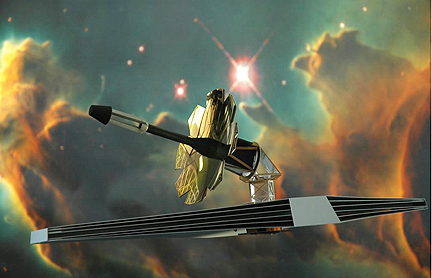Northrop Grumman... Polishing Up The Project (Satellite)
[SatNews] The first flight mirror segment for NASA's James Webb Space Telescope's (JWST) primary mirror has completed its final polishing process, the first of 18 segments that comprise the Observatory's 21 ft. primary mirror.
 James Webb Telescope, an artistic rendition
James Webb Telescope, an artistic rendition (NYSE:NOC) is leading the design and development effort for the space agency's
Goddard Space Flight Center. Performed at
Tinsley Laboratories Inc. in Richmond, Calif., the optical fabrication process is one of the longest and most rigorous steps in mirror manufacturing. Each of the 18 primary mirror segments undergoes high precision grinding, aspheric polishing and testing to tolerances as tight as 20 nanometers, or less than a millionth of an inch. Each mirror segment is polished and tested at least 30 times. After each polishing cycle, the mirror segment is cooled to 80K (-315 deg. F) in a liquid nitrogen chamber to test the polishing process, which ensures that when the mirror segment reaches cryogenic temperatures, it will change its shape into the exact optical prescription needed for the mission.
The mirror segment will next be sent to
Quantum Coatings, Inc. in Moorestown, N.J., where a thin coat of gold is deposited on the mirror's optical surface to increase its reflective properties. The layer of gold measures 120 nanometers, a thickness of about a millionth of an inch or 200 times thinner than a human hair. The segment will next be shipped to
Ball Aerospace where actuators will be added, and then on to NASA's
Marshall Space Flight Center in Huntsville, Ala., for a cryotest at minus 400 degrees Fahrenheit (near absolute zero). The first mirror segment will be closely followed by the remaining 17 segments. The
James Webb Space Telescope is the world's nexgen space observatory and successor to the
Hubble Space Telescope. The most powerful space telescope ever built, Webb will observe the most distant objects in the universe, provide images of the very first galaxies ever formed and see unexplored planets around distant stars. The Webb Telescope is a joint project of
NASA, the
European Space Agency and the
Canadian Space Agency.
Topical Tags :
Regional Tags :


